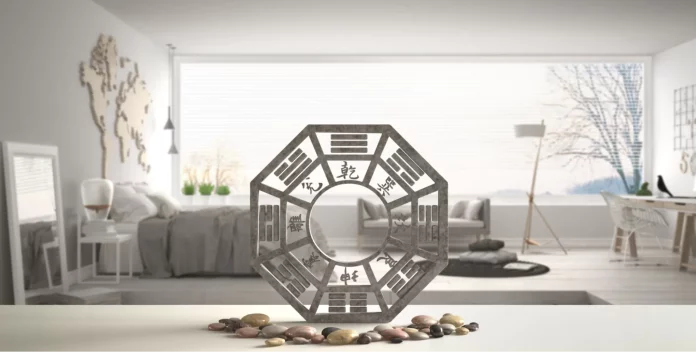
Feng Shui, an ancient Chinese art, is centered around the idea that our living spaces have a profound impact on our well-being. Translating to “wind and water,” Feng Shui is about creating harmony between our environment and the natural world. Through thoughtful arrangement and design, Feng Shui principles help us cultivate spaces that promote balance, health, and prosperity.
In interior design, Feng Shui can transform any space into a sanctuary of positive energy, where every element contributes to the overall harmony of the home.
Feng Shui Principles in Interior Design
- Bagua Areas
The Bagua is a key Feng Shui tool, often referred to as the “energy map” of a space. It divides an interior environment into nine areas, each corresponding to specific life aspects such as wealth, health, relationships, and career. Understanding the Bagua can help one to arrange their space in ways that activate positive energy in the areas of their life that need support. For instance, placing symbols of abundance in the wealth area can boost financial luck.
Image by Jenny Chang-Rodriguez / mbg Creative - Chi (Energy)
Chi, or the force of life, flows throughout the living spaces, and ensuring that it moves freely is essential for health and happiness. Blocked or stagnant chi can lead to feelings of uneasiness. In interior design, this means avoiding clutter, ensuring adequate lighting, and arranging furniture to allow easy circulation through the space.
Created by LoveToKnow / Illustrations from via Getty Images - The Five Elements
Feng Shui works on the interaction of five elements—earth, fire, water, wood, and metal- that represent different energies that can be balanced to create harmony in interior spaces. Earth brings stability and grounding; fire symbolizes passion and activity; water fosters calmness and reflection; wood encourages growth and creativity; and metal promotes clarity and precision. By balancing these elements through materials and colors, one can create a space that feels cohesive and energizing.
Understanding the 5 elements of Feng Shui | Source - Yin and Yang
The principle of yin and yang refers to the balance of opposites—light and dark, soft and hard, active and passive. Feng Shui encourages maintaining harmony between these opposing forces. For example, too much yang energy (bright lights, bold colors) can make a space feel overwhelming, while excessive yin (dark, soft, muted tones) can make it too dull. Striking the right balance between yin and yang brings equilibrium to your surroundings.
The enigmatic aura of Keerthi Tummala’s ‘LUNA’ is a testament to the harmonious interplay between the Yin and Yang aspects | Source
Feng Shui for Different Areas of a Dwelling
- Entrance and Hallways
The entrance is the mouth of chi, where energy first enters the home. To create a welcoming entrance, ensure it is well-lit and free of clutter. Clean, unobstructed doorways and hallways invite positive energy. Mirrors should be placed thoughtfully—they should reflect beauty and light rather than the entrance itself, which can cause energy to bounce out of the home. The strategic placement of plants can guide energy smoothly through the space, preventing it from becoming stagnant.
A simple layout of the Entrance Hall – Front Door, small table and a mirror | Source - Living Room
The living room is a social hub, where conversation and relaxation are key. Arrange furniture in a way that encourages interaction and fosters communication. The positioning of the sofa is crucial; it should have a solid wall behind it for support and face the room’s entrance to invite positive chi. Artwork and decor also play an important role here—choose pieces that evoke positive emotions, with colors and themes that complement the room’s energy.
To optimize feng shui, it’s important to make sure the flow of movement to and around the furniture is accessible and unobstructed | Katie Martinez Design - Bedroom
In the bedroom, the bed’s placement is paramount for restful sleep and balanced energy. Ideally, it should be placed diagonally opposite the door, with a solid wall behind it for support, creating a commanding position. Avoid positioning the bed directly in line with the door, as this can cause disruptive energy flow. Calming colors like blues and greens, natural materials, and soft textures promote relaxation and enhance comfort.
An example of the commanding position | Source - Kitchen
The kitchen, as the heart of the home, represents health and abundance. The stove, representing fire, should not be directly opposite the sink or refrigerator, as water and fire are conflicting elements. A well-organized and clean kitchen is crucial—clutter can block positive energy that promotes health and prosperity.
A well-organised and clutter-free kitchen is key | Source: Sansa Interiors
Common Feng Shui Mistakes to Avoid
The most common mistake is overloading spaces with too many decorative elements or furniture. This clutter can block the flow of chi, making a room feel cramped. Another mistake is neglecting maintenance; broken items or dirt disrupt the energy balance.

The Benefits of Feng Shui in Interior Design
Incorporating Feng Shui principles into one’s space can create calm and balanced spaces leading to a more fulfilling, stress-free life. It promotes prosperity and abundance in all forms—financial wealth, health, or positive relationships. It has the power to transform your life by supporting personal and professional growth.
Whether one is looking to boost energy, cultivate calm, or enhance abundance, Feng Shui offers a pathway to a harmonious living environment. As you explore this further, just remember that the key to is balance- in Feng Shui, and life!

References:
- https://www.housebeautiful.com/design-inspiration/a32984796/feng-shui-guide/
- https://www.masterclass.com/articles/feng-shui
- https://www.sansainteriors.com/blog/feng-shui-principles-in-interior-design#:~:text=Central%20to%20Feng%20Shui%20interior,a%20serene%20and%20welcoming%20atmosphere
- https://www.sbid.org/reasons-interior-designers-should-use-feng-shui-principles/
- https://www.qcdesignschool.com/2022/09/what-is-feng-shui-design-a-beginners-guide/
- https://www.rowabi.com/blogs/lab-of-wabi-sabi-blogs/feng-shui-interior-design
- https://www.thespruce.com/feng-shui-tips-for-beginners-1274536
- https://www.petalrepublic.com/feng-shui-basic-principles/
- https://foyr.com/learn/fengshui-design-principles
